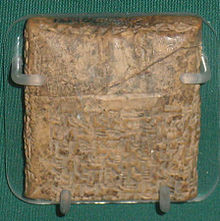Mariyannu

Mariyannu was with the Hurrians the name of one belonging to the noble warrior group calling itself by holding a chariot distinguished. This layer is attested for the kingdom of Mitanni and the cities of Alalaḫ and Ugarit in Syria. It was unknown to the Eastern Hurrites around Nuzi and Arrapḫa .
The term is derived from Sanskrit márya- ("young man"), which was expanded to include the Hurrian ending = nnu and in the plural = nni . The oldest evidence can be found in Egypt under Thutmose III. and Amenhotep III. where individual Syrian prisoners are named.
In the Mitanni empire, the Mariyanni were an influential class of aristocracy who may also instigate revolts against the king. In the war they fought as chariots drivers and were also military commanders. In the city of Alalaḫ the hereditary rank of mariyannu could be bestowed by the king. Lists of persons always state whether a Mariyannu owns a chariot or not. In Ugarit ( Ugaritic : mrynm ) the Mariyanni are usually mentioned at the top of lists of people. There was also an office of "King's Mariyannu" here.
literature
- Gernot Wilhelm : Marjannu. In: Dietz Otto Edzard (Hrsg.): Reallexikon der Assyriologie und Vorderasiatischen Aräologie . Volume 5, Walter de Gruyter, Berlin / New York 1976–1980, ISBN 3-11-007192-4 , pp. 419–421.